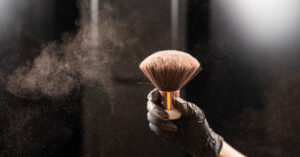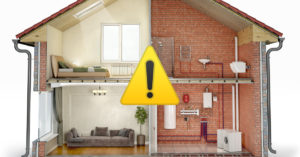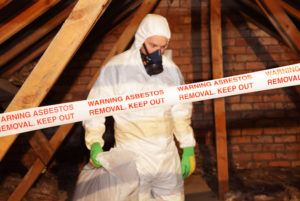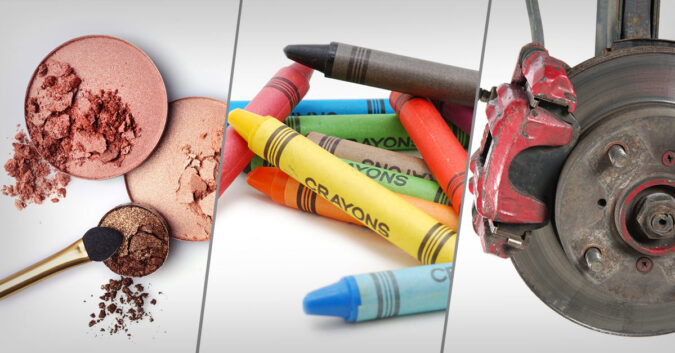For decades, asbestos was used in everything from toothpaste to cigarette filters and even the fake snow in The Wizard of Oz. Many manufacturers of asbestos-containing products hid the dangers of this mineral for decades to protect their profits.
By the late 1970s, the dangers of asbestos finally became known to the public. Exposure to asbestos can cause serious diseases like mesothelioma, asbestosis, and lung cancer. Once these risks became known, the toxic mineral was gradually phased out of use in many cases — but it is still not banned in the U.S.
Contrary to what many people may think, asbestos may still be in your home.
In fact, it’s estimated that 25 million homes in the U.S. may contain asbestos because of how frequently the mineral was used in construction materials during the 20th century.
When these asbestos-containing items are disturbed or broken down, innocent people can be put at risk of exposure and life-threatening diseases.
Anyone whose life has been forever changed by an asbestos-related illness deserves justice. See if Sokolove Law can help you with a free case review.
Get a Free Asbestos Case Review
1. Asbestos in Makeup and Personal Care Items
 Many makeup and personal care products people use every day contain talc, a mineral that absorbs moisture and reduces friction. Sadly, talc is easily contaminated with asbestos because the two minerals naturally occur together.
Many makeup and personal care products people use every day contain talc, a mineral that absorbs moisture and reduces friction. Sadly, talc is easily contaminated with asbestos because the two minerals naturally occur together.
In recent years, Johnson & Johnson (J&J) has faced lawsuits claiming its signature talcum-based baby powder exposed thousands to asbestos, causing ovarian cancer and mesothelioma.
Hair dryers made before the 1980s even contained asbestos materials to protect the electrical components from the heat. However, this led to asbestos being blown directly into a person’s nose or mouth.
The U.S. Food and Drug Administration also found that nearly 20% of popular cosmetic products contained asbestos.
It wasn’t until this year that the Environmental Protection Agency (EPA) brought cosmetic industry leaders together to discuss strict testing guidelines in efforts to decrease asbestos fibers in makeup.
Despite advocates calling for swift action to address this public health issue, cosmetic corporations continue to stall.
2. Asbestos in Children’s Toys
 Similar to makeup and baby powder, talc is often an ingredient in crayons and other popular children’s toys. The talc, contaminated with asbestos, then makes its way undetected into the hands of kids.
Similar to makeup and baby powder, talc is often an ingredient in crayons and other popular children’s toys. The talc, contaminated with asbestos, then makes its way undetected into the hands of kids.
The U.S. Public Interest Research Group found Playskool® brand crayons contained toxic levels of asbestos in 2018. While crayons are not applied to the skin, it is possible that they can be ingested by children or break down to a dust that can linger in the play area at home.
Other crayon products that were found to have asbestos include:
- Amscan® Crayons
- Disney’s Mickey Mouse Clubhouse Crayons
- Nickelodeon’s Teenage Mutant Ninja Turtle Crayons
- Saban’s Power Rangers Super Megaforce Crayons
The FDA tests of cosmetics in 2018 also found asbestos in Claire’s® makeup products marketed to children and teenagers. The company removed the products from shelves but still denied their products were unsafe.
3. Asbestos in Home Appliances
 Home appliances manufactured and installed before the 1980s often used parts containing asbestos because of the mineral’s heat resistance and durability. This was especially useful for appliances that needed to withstand extreme temperatures for decades of use.
Home appliances manufactured and installed before the 1980s often used parts containing asbestos because of the mineral’s heat resistance and durability. This was especially useful for appliances that needed to withstand extreme temperatures for decades of use.
Some appliances that may contain asbestos include:
- Clothes dryers: Several parts of a dryer — including the belts allowing the drums to spin, the insulation surrounding exhaust pipes, and other electrical components — would contain asbestos.
- Dishwashers: To prevent water damage to electrical components, dishwashers often used seals that contained asbestos.
- Electrical panels and outlets: Old panels and outlets often used asbestos-containing electrical tape and wire coatings to reduce the chances of unwanted electrical conduction, surges, and fire.
- Furnaces: Furnace flues, doors, and the wall and floor tiles surrounding the furnace often had large amounts of asbestos to keep the high temperatures from causing a fire.
- Generators: Similar to electrical panels, generators were insulated and protected from surges and fire with asbestos-containing materials.
- Refrigerators: Older refrigerators would use asbestos insulation and seals to keep the cool air from escaping and keep components safe from water damage.
- Stoves and stove hoods: Like furnace doors and flues, stoves and stove hoods needed to withstand high temperatures and frequent use. This led many older stoves to incorporate asbestos to prevent fire, heat escaping, and other damages.
- Toaster: Asbestos products were used in the casing to keep toasters from getting too hot and causing fires.
- Water heaters: Asbestos insulation would be wrapped around water heaters and pipes to retain the heat and keep the appliance working efficiently.
When replacing old appliances, it’s all too easy for homeowners or workers to be exposed to asbestos. Renovations can disturb the asbestos in older products or materials around the home that still contain asbestos, releasing microscopic fibers into the air.
However, even as the appliances get older, they could put the entire household at risk as the asbestos-containing products break down with time and use.
4. Asbestos in Brake Pads and Auto Parts
 Even the vehicles parked in your driveway or garage could expose your family to asbestos. Automotive brake pads contained asbestos because of the mineral’s durability under high friction and use.
Even the vehicles parked in your driveway or garage could expose your family to asbestos. Automotive brake pads contained asbestos because of the mineral’s durability under high friction and use.
When these brakes deteriorate and need to be replaced, it puts auto mechanics and anyone nearby at risk of inhaling asbestos fibers.
While these brake pads are no longer made in the U.S., they are still imported. Anyone could purchase these brakes online, ordering them without knowing they contain asbestos.
Although the danger is clear, an unknown number of these asbestos-containing auto parts are imported into the country each year.
Other auto parts that may contain asbestos include:
- Gaskets
- Hood liners
- Transmission plates
Many U.S. veterans who maintained military vehicles and equipment were exposed to asbestos every day, only to retire from service and be exposed again while maintaining their own vehicles.
5. Asbestos in Home Construction Materials
 If you live in a house that was built before the 1970s, there's a good chance that asbestos was used in its construction. Even if your house was built since then, asbestos may still be found in some areas of your home.
If you live in a house that was built before the 1970s, there's a good chance that asbestos was used in its construction. Even if your house was built since then, asbestos may still be found in some areas of your home.
Some construction materials that may contain asbestos include:
- Cement foundations and wallboards
- Ceiling tiles
- Electrical panels and outlets
- Gutters
- HVAC insulation and filters
- Insulation
- Outdoor siding
- Paint
- Pipes
- Popcorn ceiling texture paint
- Recessed lighting
- Roofing shingles
- Tar paper for roofs
- Vinyl flooring tiles
- Window seal putty
This puts construction workers at risk of asbestos exposure, especially when working on older buildings and renovation projects.
Sadly, even homeowners may be exposed to asbestos in your home when undertaking a renovation project. For example, popcorn ceiling asbestos fibers can easily be released into the air when scraped off or as it deteriorates over time.
Get Legal Help After Asbestos-Related Illnesses
Many may have been unknowingly exposed to asbestos through everyday household items or while undertaking a renovation project. More than 3,000 people are diagnosed with mesothelioma every year, and many more are affected by asbestos-related diseases.
With help from a compassionate mesothelioma lawyer, many people facing the realities of these terrible diseases can find the financial support they need through treatment.
Sokolove Law has over 40 years of experience as a trusted mesothelioma law firm holding the makers of asbestos-containing products accountable. We’ve recovered over $4.9 Billion for victims of mesothelioma and their families.
From filing your lawsuit and claims with asbestos trust funds, our lawyers are committed to fighting for the results our clients deserve.
If you were exposed to asbestos and later developed mesothelioma or another asbestos-related disease, take the first steps toward justice now with a free, no-obligation case review.
Note: All brands are trademarks of their respective companies.
